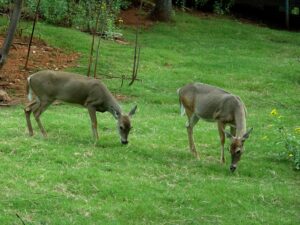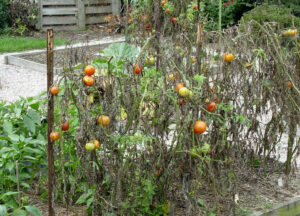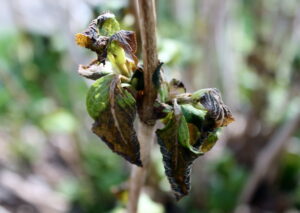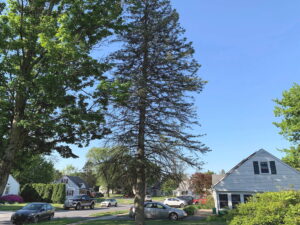Winners and Losers in a Garden of Change
September 5th, 2023
The only thing certain about gardening is that things change.

Everything changes in the garden when these come along.
Don’t ever think you’ve got gardening figured out because this is a moving target if ever there was one.
The environment around us changes.
New bugs show up.
New plants come and others go.
The weather changes – sometimes minute by minute.
And about the time you devise some kind of airtight strategy or timing, something changes (four-legged or otherwise) to make you rethink it.
We’ve had a lot of rethinking to do lately. Change seems to be happening faster than ever. (Of course, this also could be a sign that I’m getting old.)
Just in the few decades I’ve been gardening, lots of really significant garden-altering changes have happened.
I remember when gypsy moths (now known as “spongy moths”) came along to decimate oaks and cause a disgusting “rain” to fall on hikers.
Then we saw our state tree, the hemlock, attacked by cottony bugs called woolly adelgids, followed by marmorated stink bugs that invaded our houses in winter, emerald ash borers that killed off virtually all of our ash trees, and most recently the spotted lanternfly that’s swarmed into our yards in Biblical proportions.
New diseases keep coming just as fast.
For a while, anthracnose was the big news causing our native dogwoods to drop their leaves. Then a new virus showed up to add one more problem to roses (rose rosette disease), followed by a new downy mildew disease that wiped our No. 1 annual flower, impatiens, off the map until growers found a work-around, a new blight disease that turned boxwoods from a reliable evergreen into a risky choice, and most recently, worsening flareups of a pair of fungal tomato diseases (early blight and septoria) that have turned tomatoes from a fairly easy crop to grow into one that’s almost certain to die prematurely.

Tomatoes didn’t used to be this hard to grow.
None of the above were issues when I first started gardening.
I’ve also noticed a far worse deer problem; more whiteflies, aphids, and ticks; fewer bees, birds, and other pollinators; lawns that are struggling more in summer, and worse troubles with weeds, including some new ones like kudzu, the “weed orchid” (Helleborine), and the “jack-in-the-pulpit weed” (Pinellia).
As Rosanna Roseannadanna used to say on Saturday Night Live, it’s always something.
While some of the new troubles can be traced to bugs and diseases accidentally being introduced by our more worldly mobile habits, much of it is the work of a changing climate.
The biggest change I’ve noticed is how erratic our weather has become.
Events that used to be one-off oddities – ones you’d see every few decades (or maybe never) – are becoming common and expected. It’s almost normal to get the abnormal – to the point where I don’t even know what to consider “normal” anymore.
This has made plants more susceptible to a range of injuries… and gardening in general trickier than ever.
Plants can’t and don’t adapt as quickly to sudden changes as we do. They can’t go inside in the air-conditioning when temperatures swelter into the 90s, for example, and they can’t put up an umbrella when a storm dumps five inches of rain in a half-hour.
The tough part is that there’s not a lot we can do about much of this.
A prime example is the exaggerated up-and-down temperatures we’ve seen going into and coming out of winter.

This is what happens when hydrangea leaf buds open too early, then a cold snap hits.
I remember when we used to get cold weather starting in November, and it would stay consistently cold until what was then called the “spring thaw.” It wasn’t unusual to have snow cover all or most of the winter.
Now, most of our winters don’t have that soil-insulating snow cover, and it’s not unusual to have temperature spells in the 50s, 60s, or even 70s in January or February.
While that’s welcome news for snow-haters, the problem is that plants and their buds develop far too early in the season. Flower buds are sometimes opening weeks sooner than the past norm.
Then when even a “normal” cold spell returns, the plants suffer far more bud and branch death than if they were in their winter-dormant state.
My landscape has suffered a lot of mayhem from this temperature yo-yoing. Tops on that list was losing a $100 young cutleaf Japanese maple that releafed after the first yo-yo but then died when a frost killed the backup set of foliage. It was like the plant said, “I’ll give you one strike, but two strikes and I’m out.”
Since there’s not much any one of us can do to change the change, our only choice is to adapt to what we can and roll with the punches on what we can’t.
Chief on that list is plant selection.
Now that our recent climate norms have us more akin to the climate that used to be the norm in Baltimore, we should be leaning more toward plants that do well in warmer summers and less-cold winters. (One study projects us with an eight-degree-warmer climate by 2080, making us similar to what Jonesboro, Ark., is like now.)
The flip side is to think twice before planting species that prefer it colder, including ones we’ve grown successfully for decades that are now struggling in recent conditions.

Many Colorado blue spruces are thinning and dying.
A case in point is the Colorado blue spruce, once a favorite conifer in Harrisburg-area yards for its sleek habit and blue needles.
Blue spruces have been dying for years now, making them a leading removal species for tree companies. Although disease is the death-certificate culprit, arborists believe the warmer weather has stressed the species and made it more susceptible to disease. (Although blue spruce is a native species, it’s native to the cooler mountain regions of the western U.S.)
Other species we’ve long planted that aren’t faring as well lately in our warming weather include sugar maple, Norway and Serbian spruce, Douglas fir, white and gray birch, black cherry, American beech, American linden, katsura, and hop-hornbeam.
On the other hand, species that used to be considered “borderline-hardy” or “envelope-pushing” plants in the Harrisburg area are now becoming better and better bets, including crape myrtle, aucuba, cherry laurel, nandina, osmanthus, sweetbox, photinia, and maybe even skimmia and loropetalum.
Before you go whole-hog into palms, though, keep in mind that the volatility of any year’s weather could well give us a record-setting low sandwiched between a pair of unusually warm spells. And one night is all it takes to kill a marginally adapted tree or shrub sited out of its low-tolerance range (as happened this past winter).
Read more on how one of the warmest winters ever caused some of the worst plant damage ever
A second thing we can do is stay on top of what’s new with bugs, weeds, and diseases and be ready to cope with the latest in “challenges.”
Third, be willing to shift gears and adjust even long-held time schedules and practices.
Those earlier springs might mean we can move up our planting times in May, while later frosts in fall might mean it’s increasingly possible to squeeze out veggie-garden harvests into November.
The bottom line is that although it’s not exactly time to start gardening like it’s Washington, we also can’t keep gardening like it’s 1950 and expect to have the same results.
As in any change, there will be winners, and there will be losers.
The quicker we are at figuring out which is which, the better we’re likely to do in the garden.
Read more in my PennLive column on what changes in our climate mean to gardening
Read more in my PennLive column on how to garden in the “new normal”







